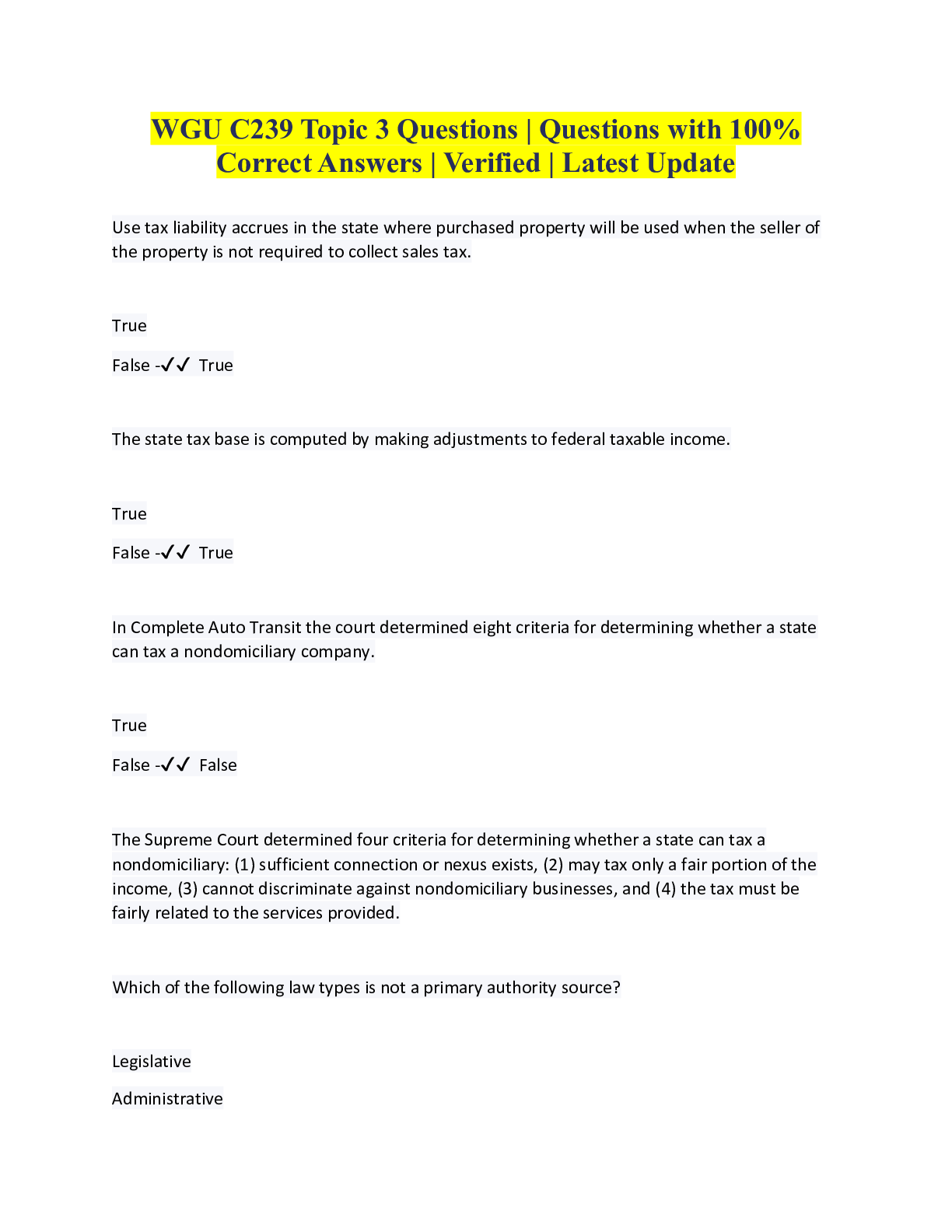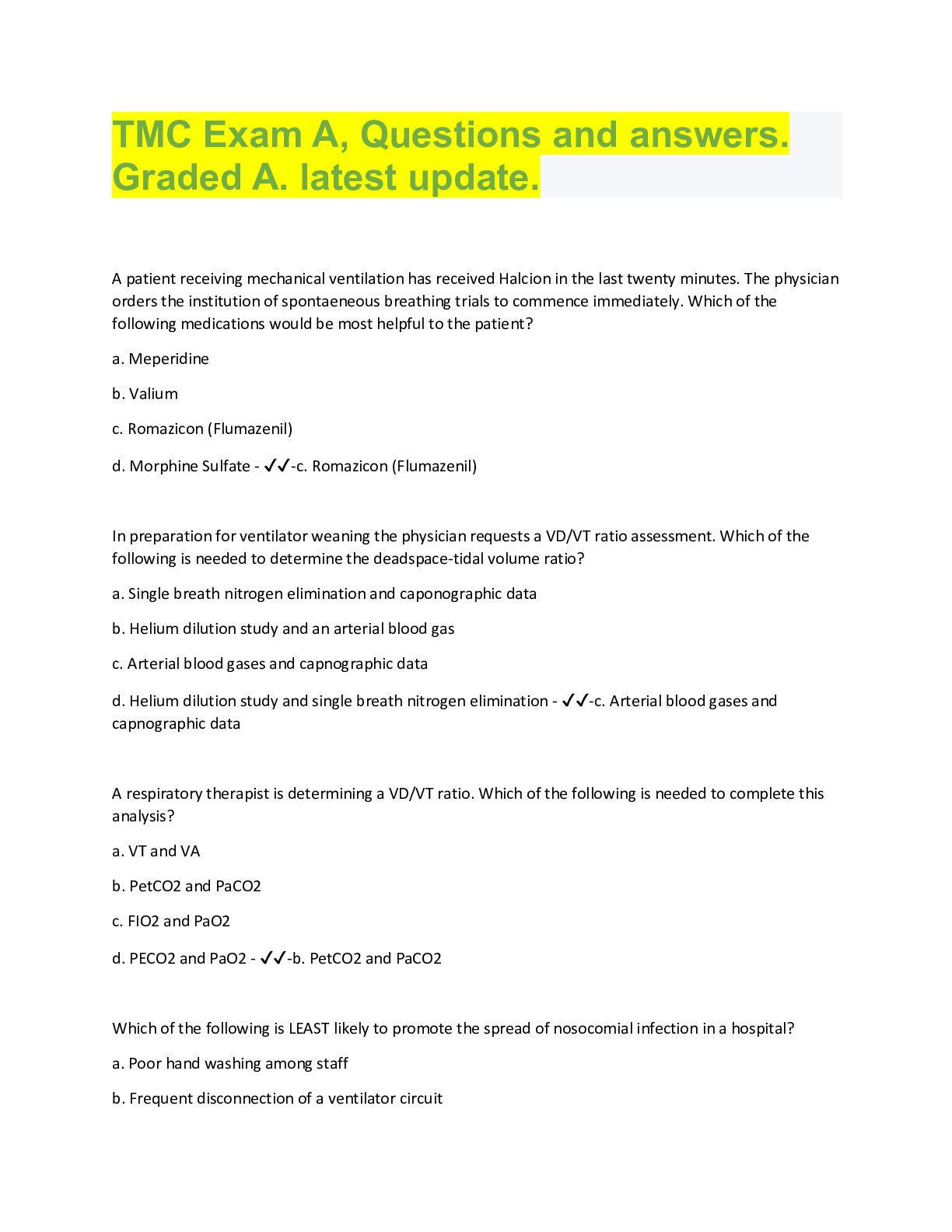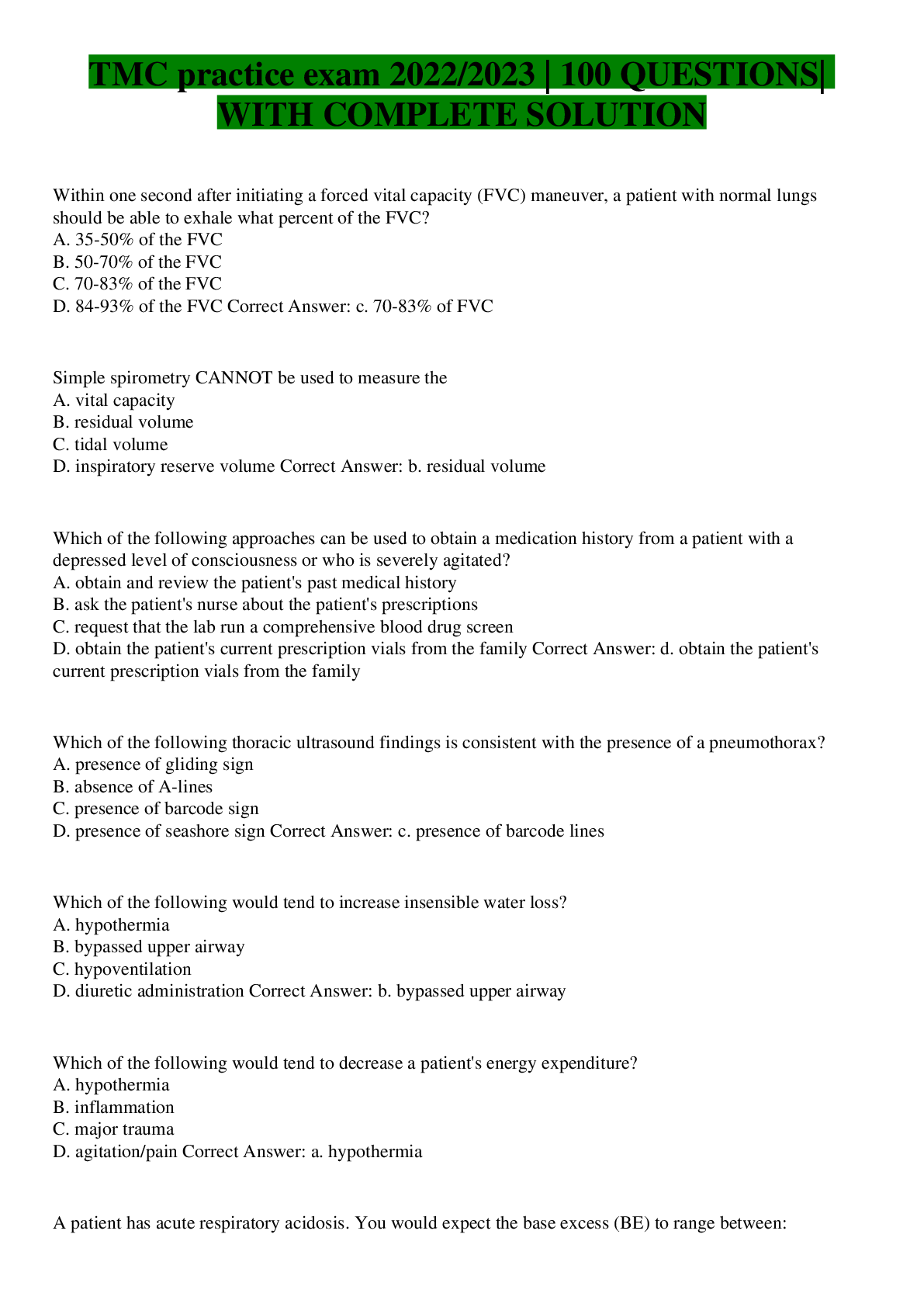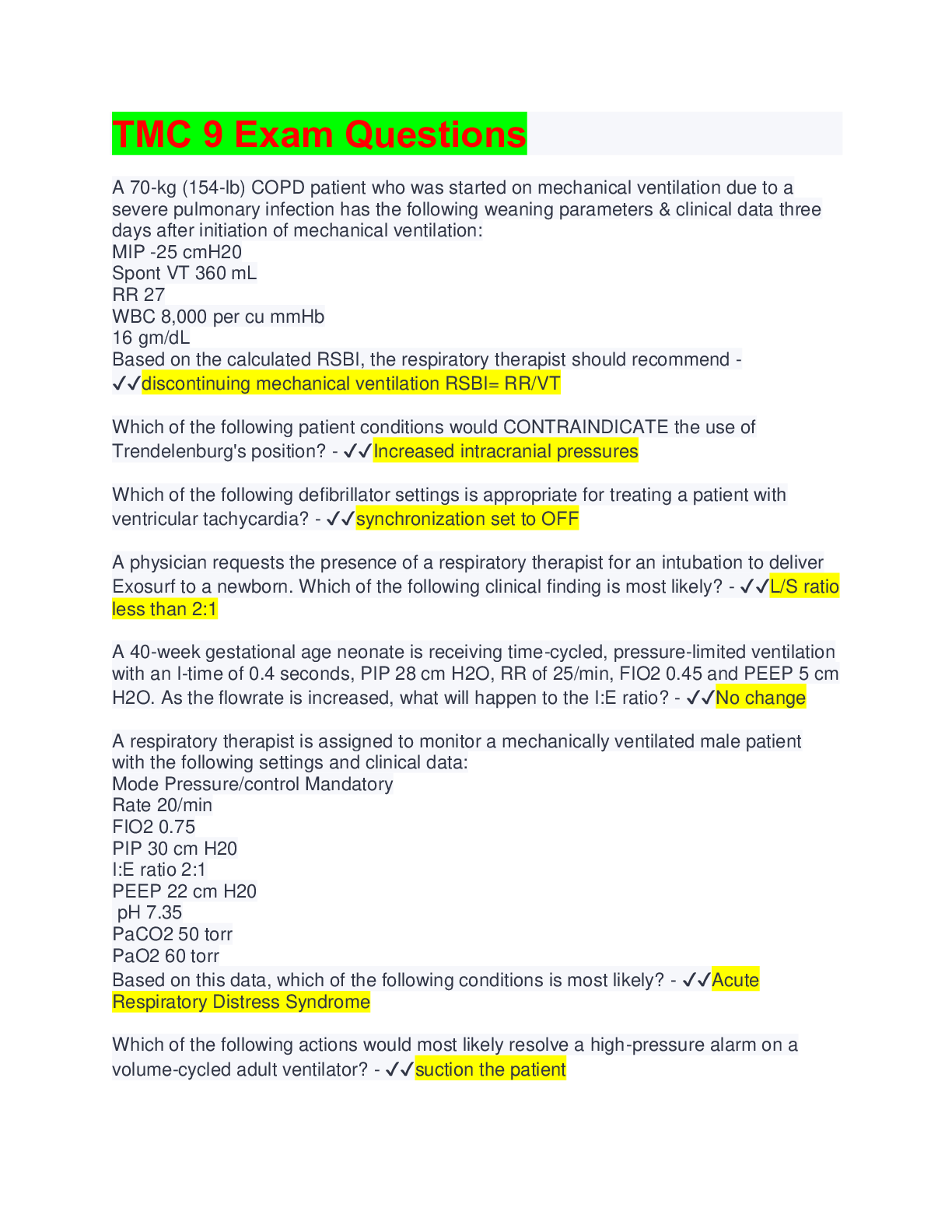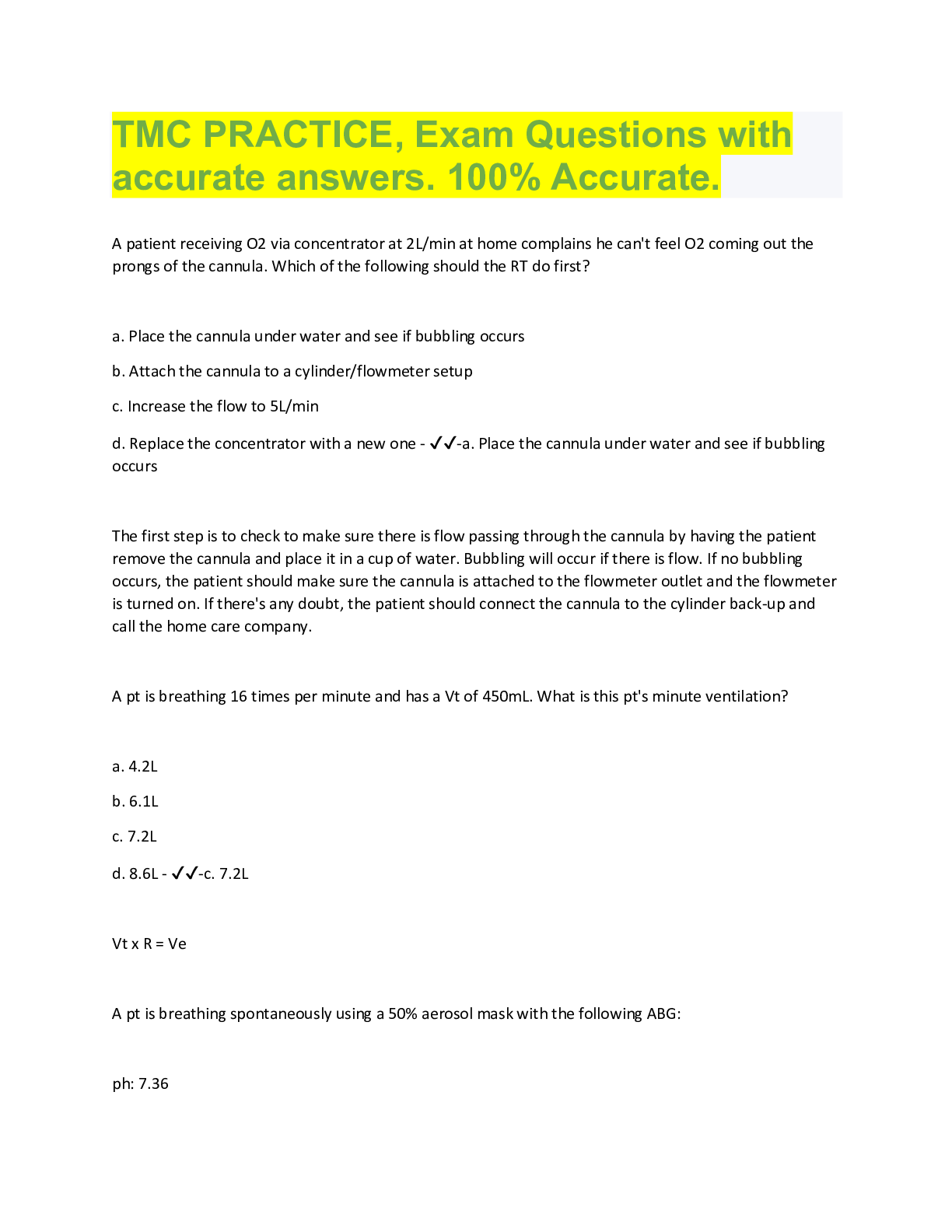Management > QUESTIONS & ANSWERS > Chapter 01 - The Nature of Negotiation University of MemphisMGMT 4510Test 1 study ( 86 MCQ QUESTIONS (All)
Chapter 01 - The Nature of Negotiation University of MemphisMGMT 4510Test 1 study ( 86 MCQ QUESTIONS WITH 100% CORRECT ANSWERS MARKED IN BOLD )
Document Content and Description Below
Chapter 01 - The Nature of Negotiation 1. 41. (p. 3) Which perspective can be used to understand different aspects of negotiation? A. Economics B. Psychology C. Anthropology D. Law E. All of th... e above perspectives can be used to understand different aspects of negotiation. 2. 42. (p. 3) To most people the words "bargaining" and "negotiation" are A. mutually exclusive. B. interchangeable. C. not related. D. interdependent. E. None of the above. 3. 43. (p. 3) A situation in which solutions exist so that both parties are trying to find a mutually acceptable solution to a complex conflict is known as which of the following? A. Mutual gains B. Win-lose C. Zero-sum D. Win-win E. None of the above. 4. 44. (p. 8) Which is not a characteristic of a negotiation or bargaining situation? A. Conflict between parties B. Two or more parties involved C. An established set of rules D. A voluntary process E. None of the above is a characteristic of a negotiation. 1-1Chapter 01 - The Nature of Negotiation 5. 45. (p. 8) Tangible factors A. include the price or terms of agreement. B. are psychological motivations that influence the negotiations. C. include the need to look good in negotiations. D. cannot be measured in quantifiable terms. E. None of the above statements describe tangible factors. 6. 46. (p. 8) Which of the following is not an intangible factor in a negotiation? A. The need to look good B. The need to arrive at the final agreed price on a contract C. The need to defend an important principle D. The need to win E. All of the above are intangible factors. 7. 47. (p. 10) Interdependent parties' relationships are characterized by A. interlocking goals. B. solitary decision making. C. established procedures. D. rigid structures. E. Interdependent relationships are characterized by all of the above. 8. 48. (p. 10) A zero-sum situation is also known by another name of a situation. Which of the following is that? A. Integrative B. Distributive C. Win-lose D. Negotiative E. None of the above. 9. 50. (p. 14) What are the two dilemmas of negotiation? A. The dilemma of cost and the dilemma of profit margin B. The dilemma of honesty and the dilemma of profit margin C. The dilemma of trust and the dilemma of cost D. The dilemma of honesty and the dilemma of trust E. None of the above. 1-2Chapter 01 - The Nature of Negotiation 10. 51. (p. 14) How much to believe of what the other party tells you A. depends on the reputation of the other party. B. is affected by the circumstances of the negotiation. C. is related to how he or she treated you in the past. D. is the dilemma of trust. E. All of the above. 11. 52. (p. 15) Satisfaction with a negotiation is determined by A. the process through which an agreement is reached and the dollar value of concessions made by each party. B. the actual outcome obtained by the negotiation as compared to the initial bargaining positions of the negotiators. C. the process through which an agreement is reached and by the actual outcome obtained by the negotiation. D. the total dollar value of concessions made by each party. E. Satisfaction with a negotiation is determined by none of the above. 1-3Chapter 01 - The Nature of Negotiation 12. 53. (p. 18) Which of the following statements about conflict is true? A. Conflict is the result of tangible factors. B. Conflict can occur when two parties are working toward the same goal and generally want the same outcome. C. Conflict only occurs when both parties want a very different settlement. D. Conflict has a minimal effect on interdependent relationships. E. All of the above statements about conflict are true. 13. 54. (p. 18) In intragroup conflict, A. sources of conflict can include ideas, thoughts, emotions, values, predispositions, or drives that are in conflict with each other. B. conflict occurs between individual people. C. conflict affects the ability of the group to resolve differences and continue to achieve its goals effectively. D. conflict is quite intricate because of the large number of people involved and possible interactions between them. E. None of the above describes intragroup conflict. 14. 55. (p. 19) Which of the following contribute to conflict's destructive image? A. Increased communication B. Misperception and bias C. Clarifying issues D. Minimized differences; magnified similarities E. All of the above contribute to conflict's destructive image. 15. 56. (p. 22) In the Dual Concerns Model, the level of concern for the individual's own outcomes and the level of concern for the other's outcomes are referred to as the A. cooperativeness dimension and the competitiveness dimension. B. the assertiveness dimension and the competitiveness dimension. C. the competitiveness dimension and the aggressiveness dimension. D. the cooperativeness dimension and the assertiveness dimension. E. None of the above. 1-4Chapter 01 - The Nature of Negotiation 16. 57. (p. 23) An individual who pursues his or her own outcomes strongly and shows little concern for whether the other party obtains his or her desired outcomes is using another of the following strategies. Which one? A. Yielding B. Compromising C. Contending D. Problem solving E. None of the above. 17. 58. (p. 23) Negotiators pursuing the yielding strategy A. show little interest or concern in whether they attain their own outcomes, but are quite interested in whether the other party attains his or her outcomes. B. pursue their own outcome strongly and shows little concern for whether the other party obtains his or her desired outcome. C. shows little interest or concern in whether they attain their own outcomes, and does not show much concern about whether the other party obtains his or her outcomes. D. show high concern for attaining their own outcomes and high concern for whether the other attains his or her outcomes. E. Negotiators pursuing the yielding strategy demonstrate none of the above behaviors. 18. 59. (p. 23, 24) Parties pursuing one of the following strategies show little interest or concern in whether they attain their own outcomes, and do not show much concern about whether the other party obtains his or her outcomes. Which of the ones listed below? A. Contending B. Compromising C. Problem solving D. Yielding E. None of the above. Chapter 2 19. 49. (p. 28) Distributive bargaining strategies A. are the most efficient negotiating strategies to use. B. are used in all interdependent relationships. C. are useful in maintaining long term relationships. D. can cause negotiators to ignore what the parties have in common. E. None of the above describes distributive bargaining strategies. 1-5Chapter 01 - The Nature of Negotiation 20. 50. (p. 29) The target point is the A. point at which a negotiator would like to conclude negotiations. B. negotiator's bottom line. C. first offer a negotiator quotes to his opponent. D. initial price set by the seller. E. None of the above describes the target point. 21. 51. (p. 29) Starting points A. are usually contained in the opening statements each negotiator makes. B. are usually learned or inferred as negotiations get under way. C. are not known to the other party. D. are given up as concessions are made. E. None of the above describes starting points. 22. 52. (p. 31) The objective of both parties in distributive bargaining is to obtain as much of which of the following as possible? A. Bargaining range B. Resistance point C. Target point D. Bargaining mix E. None of the above. 1-6Chapter 01 - The Nature of Negotiation 23. (p. 34) The resistance point is established by the ____________ expected from a particular outcome, which is in turn the product of the ____________ and ____________ of an outcome. A. cost, value, worth B. value, worth, cost C. value, cost and timeliness D. cost, importance, value E. None of the above. 24. 54. (p. 39) A large majority of agreements in distributive bargaining are reached when the deadline is A. near. B. flexible. C. past. D. undefined. E. None of the above. 25. 55. (p. 40) Disruptive action tactics can cause A. embarrassment. B. increased costs. C. anger. D. escalation of conflict. E. Disruptive action tactics can cause all of the above. 26. 56. (p. 42) The opening stance is A. another name for the first round of concessions. B. the first price that a buyer quotes to a seller. C. the attitude to adopt during the negotiation. D. a package of concessions. E. All of the above describe the opening stance. 1-7Chapter 01 - The Nature of Negotiation 27. 57. (p. 42) The bargaining range is defined by A. the opening stance and the initial concession. B. the initial round of concessions. C. the bargaining mix and the opening stance. D. the opening offer and the counteroffer. E. The bargaining range is defined by all of the above. 28. 58. (p. 42) What action can be taken after the first round of offers? A. Hold firm B. Insist on the original position C. Make some concessions D. Make no concessions E. All of the above. 29. 59. (p. 43) Good distributive bargainers will A. begin negotiations with the other party with an opening offer close to their own resistance point. B. ensure that there is enough room in the bargaining range to make some concessions. C. accept an offer that is presented as a fait accompli. D. immediately identify the other party's target point. E. All of the above are actions that good distributive bargainers will take. 30. 60. (p. 43) Parties feel better about a settlement when negotiations involve a(n) A. immediate settlement. B. single round of concessions. C. progression of concessions. D. fait accompli. E. All of the above. 1-8Chapter 01 - The Nature of Negotiation 31. 61. (p. 44) What statement about concessions is false? A. Concessions are central to negotiations. B. Concessions is another word for adjustments in position. C. Concession making exposes the concession maker to some risk. D. Reciprocating concessions is a haphazard process. E. All of the above statements are true. 32. 62. (p. 44) Concession making A. indicates an acknowledgment of the other party. B. shows a movement toward the other's position. C. implies a recognition of the legitimacy of the other party's position. D. recognizes the other party's position. E. All of the above are characteristics of concession making. 33. 63. (p. 44) When successive concessions get smaller, the most obvious message is that A. the negotiator is reaching the fatigue point. B. the resistance point is being reached. C. the concession maker's position is weakening. D. the negotiator has passed the resistance point. E. None of the above. 34. 64. (p. 45) Skilled negotiators may A. suggest different forms of a potential settlement that are worth about the same to them. B. recognize that not all issues are worth the same amount to both parties. C. frequently save a final small concession for near the end of the negotiation to "sweeten" the deal. D. make the last concession substantial to indicate that "this is the last offer". E. Skilled negotiators may take all of the above actions. 1-9Chapter 01 - The Nature of Negotiation 35. 65. (p. 46) A commitment A. should not be interpreted as a threat. B. postpones the threat of future action. C. is designed to increase both parties' choices to a portfolio of options. D. removes ambiguity about the actor's intended course of action. E. All of the above. 36. 66. (p. 47) A commitment statement should have A. a low degree of finality. B. a high degree of specificity. C. an indefinite statement of consequences. D. a high degree of emotionality. E. None of the above should be included in a commitment statement. 37. 67. (p. 48) Negotiators who make threats A. are perceived as more powerful than negotiators who do not use threats. B. receive higher outcomes than negotiators who do not use threats. C. are perceived as more cooperative in distributive negotiations. D. should use detailed, complex statements of demands, conditions and consequences. E. All of the above describe negotiators who make threats. 38. 68. (p. 49) To prevent the other party from establishing a committed position, a negotiator could A. give them the opportunity to evaluate the matter fully. B. acknowledge the other's commitment. C. reiterate the commitment. D. make a joke about the commitment. E. None of the above should be used to prevent the other party from establishing a committed position. 1-10Chapter 01 - The Nature of Negotiation 39. 69. (p. 52) Hardball tactics are designed to A. be used primarily against powerful negotiators. B. clarify the user's adherence to a distributive bargaining approach. C. pressure targeted parties to do things they would not otherwise do. D. eliminate risk for the person using the tactic. E. Hardball tactics are designed to accomplish all of the above. 40. 70. (p. 59) Aggressive behavior tactics include A. the relentless push for further concessions. B. asking for the best offer early in negotiations. C. asking the other party to explain and justify their proposals item by item. D. forcing the other side to make many concessions to reach an agreement. E. Aggressive behavior tactics include all of the above. 41. 71. (p. 60) The negotiator's basic strategy is to A. get information about the opposition and its positions. B. reach the final settlement as close to the other's resistance point as possible. C. convince members of the other party to change their minds about their ability to achieve their own goals. D. promote his or her own objectives as desirable, necessary, and inevitable. E. All of the above. Ch 3 42. 47. (p. 62, 63) Which of the following is not an element of integrative negotiations? A. A focus on commonalties B. An attempt to address positions C. A required exchange of information and ideas D. The use of objective criteria for standards of performance E. All of the above are elements of integrative negotiations. 1-11Chapter 01 - The Nature of Negotiation 43. 48. (p. 63) Which of the following processes is central to achieving almost all integrative agreements? A. Moderating the free flow of information to ensure that each party's position is accurately stated B. Exchanging information about each party's position on key issues C. Emphasizing the commonalties between the parties D. Searching for solutions that maximize the substantive outcome for both parties E. All of the above processes are central to achieving integrative agreements. 44. 49. (p. 66) Which of the following is a major step in the integrative negotiation process? A. Identifying and defining the problem B. Understanding the problem and bringing interests and needs to the surface C. Generating alternative solutions to the problem D. Choosing a specific solution E. All of the above are major steps in the integrative negotiation process. 1-12Chapter 01 - The Nature of Negotiation 45. 50. (p. 67 - 69) In which major step of the integrative negotiation process of identifying and defining the problem would you likely find that if the problem is complex and multifaceted the parties may not even be able to agree on a statement of the problem? A. Define the problem in a way that is mutually acceptable to both sides. B. State the problem with an eye toward practicality and comprehensiveness. C. State the problem as a goal and identify the obstacles to attaining this goal. D. Depersonalizing the problem. E. Separate the problem definition from the search for solutions. 46. 51. (p. 70) An interest is instrumental if A. the parties value it because it helps them derive other outcomes in the future. B. the parties value the interest in and of itself. C. it relates to "tangible issues" or the focal issues under negotiation. D. the relationship is valued for both its existence and for the pleasure that sustaining the relationship creates. E. All of the above relate to instrumental interests. 47. 52. (p. 70) Substantive interests A. are the interests that relate to the focal issues under negotiation. B. are related to the way we settle the dispute. C. mean that one or both parties value their relationship with each other and do not want to take actions that will damage the relationship. D. regard what is fair, what is right, what is acceptable, what is ethical, or what has been done in the past and should be done in the future. E. All of the above relate to substantive interests. 48. 53. (p. 71) Which of the following statements about interests is true? A. There is only one type of interest in a dispute. B. Parties are always in agreement about the type of interests at stake. C. Interests are often based in more deeply rooted human needs or values. D. Interests do not change during the course of an integrative negotiation. E. All of the above statements about interests are true. 1-13Chapter 01 - The Nature of Negotiation 49. 54. (p. 74) Successful logrolling requires A. that the parties establish more than one issue in conflict and then agree to trade off among these issues so one party achieves a highly preferred outcome on the first issue and the other person achieves a highly preferred outcome on the second issue. B. no additional information about the other party than his/her interests, and assumes that simply enlarging the resources will solve the problem. C. that one party is allowed to obtain his/her objectives and he/she then "pays off" the other party for accommodating his/her interests. D. a fundamental reformulation of the problem such that the parties are disclosing sufficient information to discover their interests and needs and then inventing options that will satisfy both parties' needs. E. Successful logrolling requires all of the above. 50. 55. (p. 76) What approach can parties use to generate alternative solutions by redefining the problem or problem set? A. Brainstorming B. Logrolling C. Surveys D. Nonspecific compensation E. None of the above approaches can be used to redefine the problem. 51. 56. (p. 76) In nonspecific compensation A. resources are added in such a way that both sides can achieve their objectives. B. one party achieves his/her objectives and the other's costs are minimized if he/she agrees to go along. C. the parties are able to invent new options that meet each sides' needs. D. one person is allowed to obtain his/her objectives and "pay off" the other person for accommodating his interests. E. All of the above are related to nonspecific compensation. 52. 57. (p. 77) What questions can be asked to facilitate nonspecific compensation? A. What are the other party's goals and values? B. How can both parties get what they are demanding? C. What issues are of higher and lower priority to me? D. What risks and costs does my proposal create for the other? E. None of the above can be used to facilitate nonspecific compensation. 1-14Chapter 01 - The Nature of Negotiation 53. 58. (p. 77) "What are the other's real underlying interests and needs?" is a question that can facilitate the _____________ process. A. expanding the pie B. logrolling C. nonspecific compensation D. bridging E. The question should not be used with any of the above processes. 54. 59. (p. 76, 77) In brainstorming A. individuals work in a large group to select a single optimal solution. B. all solutions are judged and critiqued as they are recorded, and a weighted-average percentage is assigned to each solution. C. parties are urged to be spontaneous and even impractical. D. the success of the approach depends on the item-by-item evaluation and critique of the solutions as presented. E. None of the above is a part of the brainstorming process. 55. 60. (p. 78) When identifying options in an integrative negotiation, solutions are usually attained through: A. hard work B. information exchange C. focusing on interests rather than positions D. firm flexibility E. Solutions are attained by using all of the above. 56. 61. (p. 78 - 81) When confronted with complex problems, or a large number of alternative options, which of the following steps is necessary? A. Broaden the range of solution options B. Evaluate solutions on the basis of quality, standards, and acceptability C. Decide on criteria while evaluating options D. Maintain a focus on the influence of tangibles in selecting options E. All of the above steps should be used when confronted with complex problems. 1-15Chapter 01 - The Nature of Negotiation 57. 62. (p. 80) Which guideline should be used in evaluating options and reaching a consensus? A. Keep the range of solution options as wide as possible B. Evaluate the solutions on the basis of speed and expediency C. Keep detailed records throughout the discussion and evaluation process D. Be alert to the influence of intangibles in selecting options E. None of the above should be used in the evaluation process. 58. 63. (p. 82) A common goal is one in which A. all parties share the result equally. B. the parties work toward a common end but benefit differently. C. all parties work together to achieve some output that will be shared. D. individuals with different personal goals agree to combine them in a collective effort. E. All of the above are characteristics of a common goal. 59. 64. (p. 83) A joint goal is one in which A. all parties share the result equally. B. the parties work toward a common end but benefit differently. C. individuals with different personal goals agree to combine them in a collective effort. D. all parties work together to achieve some output that will be shared. E. All of the above are characteristics of a common goal. 60. 65. (p. 84) Which of the following is not necessary for integrative negotiation to succeed? A. Each party should be as interested in the objectives and problems of the other as each is in his/her own—each must assume responsibility for the other's needs and outcomes as well as for his/her own. B. The parties must be committed to a goal that benefits both of them rather than to pursuing only their own ends. C. The parties must be willing to adopt interpersonal styles that are more congenial than combative, more open and trusting than evasive and defensive, more flexible (but firm) than stubborn (but yielding). D. Needs have to be made explicit, similarities have to be identified, and differences have to be recognized and accepted. E. All of the above are essential for integrative negotiation to succeed. 1-16Chapter 01 - The Nature of Negotiation 61. 66. (p. 84) Which of the following is a major characteristic of a pre-settlement settlement? A. The settlement results in a firm, legally binding written agreement between the parties. B. It occurs in advance of the parties undertaking a full-scale negotiation. C. The parties intend that the agreement will be replaced by a more clearly delineated long-term agreement which is to be negotiated. D. It resolves only a subset of the issues on which the parties disagree, and may simply establish a framework within which the more comprehensive agreement can be defined and delineated. E. All of the above are characteristics of a pre-settlement settlement. 62. 67. (p. 85) Which of the following factors does not contribute to the development of trust between negotiators? A. We are more likely to trust someone we perceive as similar to us or as holding a positive attitude toward us. B. We often mistrust people who are dependent upon us because we are in a position to help or hurt them. C. We are more likely to trust people who initiate cooperative, trusting behavior. D. We are more likely to trust negotiators who make concessions. E. All of the above contribute to the development of trust between negotiators. 63. 68. (p. 85) When people do not trust each other they are more than likely to engage in which of the following behaviors? A. Promoting collaboration B. Communicating accurately C. Positional bargaining D. Committing to a joint solution E. None of the above chapter 4 64. 45. (p. 89) What are the most critical precursors for achieving negotiation objectives? A. Effective strategizing, planning and preparation B. Goal setting and target planning C. Defining frames and setting goals D. Framing and strategizing E. None of the above 1-17Chapter 01 - The Nature of Negotiation 65. 46. (p. 90) A negotiator's goals: A. are intrinsically in conflict with his opponent's goals B. have no boundaries or limits C. are explicitly stated wishes D. must be reasonably attainable E. all of the above 66. 47. (p. 90) The less concrete and measurable goals are: A. the harder it is to communicate to the other party what we want B. the easier it is to understand what your opponent wants C. the easier it is to determine whether a particular outcome satisfies our goals D. the harder it is to restate what the initial goal was E. all of the above 1-18Chapter 01 - The Nature of Negotiation 67. 48. (p. 91) Which is not a difference between strategy and tactics? A. Scale B. Goals C. Perspective D. Immediacy 68. 49. (p. 92, 93) A strong interest in achieving only substantive outcomes tends to support which of the following strategies? A. Collaborative B. Accommodating C. Competitive D. Avoidance E. None of the above 69. 50. (p. 93) A strong interest in achieving only the relationship outcomes suggests one, if any, of the following strategies. Which one? A. Competitive B. Accommodation C. Collaborative D. Avoidance E. None of the above 70. 51. (p. 93) Avoidance could best be used when: A. negotiation is necessary to meet your needs. B. the time and effort to negotiate are negligible. C. the available alternatives are very strong. D. the only available negotiator is a senior manager. E. all of the above. 1-19Chapter 01 - The Nature of Negotiation 71. 52. (p. 93) Which one of the following is as much a win-lose strategy as competition, although it has a decidedly different image? A. Collaboration B. Avoidance C. Engagement D. Accommodation 72. 53. (p. 95) Characteristics of collaborative strategies include: A. long-term focus B. trust and openness C. efforts to find mutually satisfying solutions D. pursuit of goals held jointly with others E. all of the above 73. 54. (p. 95) In an accommodative negotiation, the relationships have: A. a short-term focus B. a long-term focus C. may be either short term or long term D. none of the above 74. 55. (p. 95) Accommodative strategies emphasize: A. Subordinating one's own goals in favor of those of others. B. Secrecy and defensiveness. C. Abandonment of bad images and consideration of ideas based on merit. D. A key attitude of "I win; you lose". E. All of the above. 75. 56. (p. 96) Getting to know the other party and understanding similarities and differences represents what key step in the negotiation process: A. preparation B. information gathering C. relationship building D. information using E. None of the above 1-20Chapter 01 - The Nature of Negotiation 76. 57. (p. 96) Which is not a key step to an ideal negotiation process? A. Preparation B. Relationship Building C. Information Gathering D. Bidding E. All of the above are key steps 77. 58. (p. 97) What is the dominant force for success in negotiation? A. A distributive vs. integrative strategy B. The planning that takes place prior to the dialogue C. The discussions that precede planning sessions D. The tactics selected in support of strategic goals E. All of the above 78. 59. (p. 97) Effective planning requires hard work on the following points: A. Defining the issues B. Defining the bargaining limit C. Defining interests D. Defining limits and alternatives E. All of the above 79. 60. (p. 100) Interests can be: A. substantive, directly related to the focal issues under negotiation B. process based, related to the manner in which we settle this dispute C. relationship based, tied to the current or desired future relationship between the parties D. based in the intangibles of the negotiation E. all of the above 80. 61. (p. 100, 101) Which is not true of limits? A. Limits are the point where you should stop the negotiation. B. Limits are also called resistance points. C. Establishing limits is a critical part of planning. D. Limits should be ignored in a bidding war. E. All of the above are true about limits. 1-21Chapter 01 - The Nature of Negotiation 81. 62. (p. 101) Does any of the following represent the point at which we realistically expect to achieve a settlement? A. Specific target point B. Resistance point C. Alternative D. Asking price E. None of the above 82. 63. (p. 101) Which represents the best deal we can possibly hope to achieve? A. Specific target point B. Resistance point C. Alternative D. Asking price E. None of the above 83. 64. (p. 102) Reactive strategies: A. encourage negotiators to be more flexible and creative B. can efficiently clear up confusion about issues C. will lessen a negotiator's defensive posture D. can make negotiators feel threatened and defensive E. none of the above 84. 65. (p. 106) If the other party has a strong and viable alternative, he/she will A. be dependent on achieving a satisfactory agreement B. appear aggressive and hostile in negotiations C. set and push for high objectives D. have unlimited negotiating authority E. all of the above 1-22Chapter 01 - The Nature of Negotiation 85. 66. (p. 109) A negotiator should ask which of the following questions when presenting issues to the other party to assemble information? A. What facts support my point of view? B. Whom may I consult or take with to help me elaborate or clarify the facts? C. What is the other party's point of view likely to be? D. How can I develop and present the facts so they are most convincing? E. All of the above questions should be asked. 86. 67. (p. 110) Under which of the following questions of protocol would you find a bargaining relationship discussion about procedural issues that should occur before the major substantive ones have been raised? A. What agenda should we follow? B. Where should we negotiate? C. What is the time period of the negotiation? D. What might be done if negotiation fails? E. How will we keep track of what is agreed to? 1-23 [Show More]
Last updated: 1 year ago
Preview 1 out of 23 pages
Instant download

Instant download
Reviews( 0 )
Document information
Connected school, study & course
About the document
Uploaded On
Jun 12, 2021
Number of pages
23
Written in
Additional information
This document has been written for:
Uploaded
Jun 12, 2021
Downloads
0
Views
28

.png)
.png)
.png)


.png)
.png)
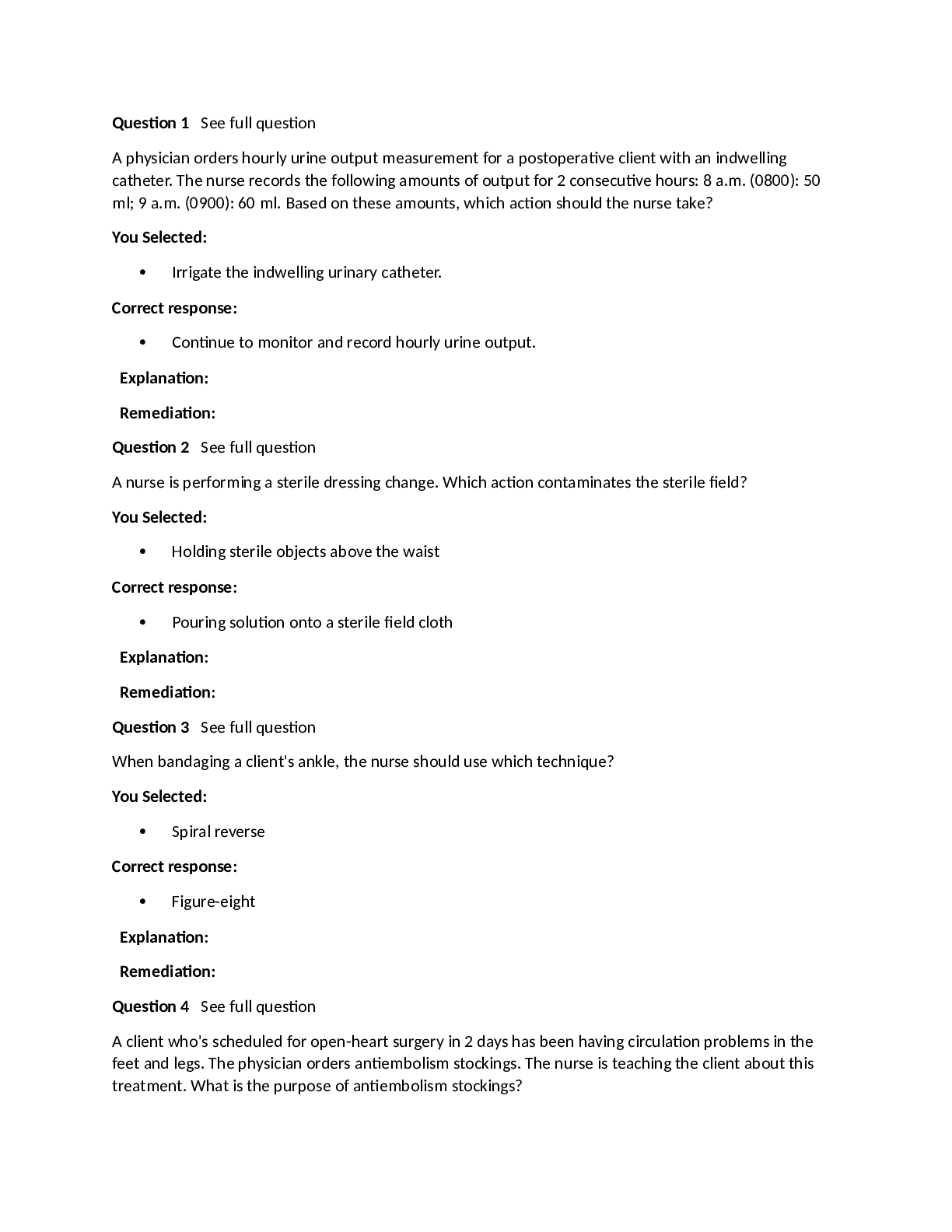

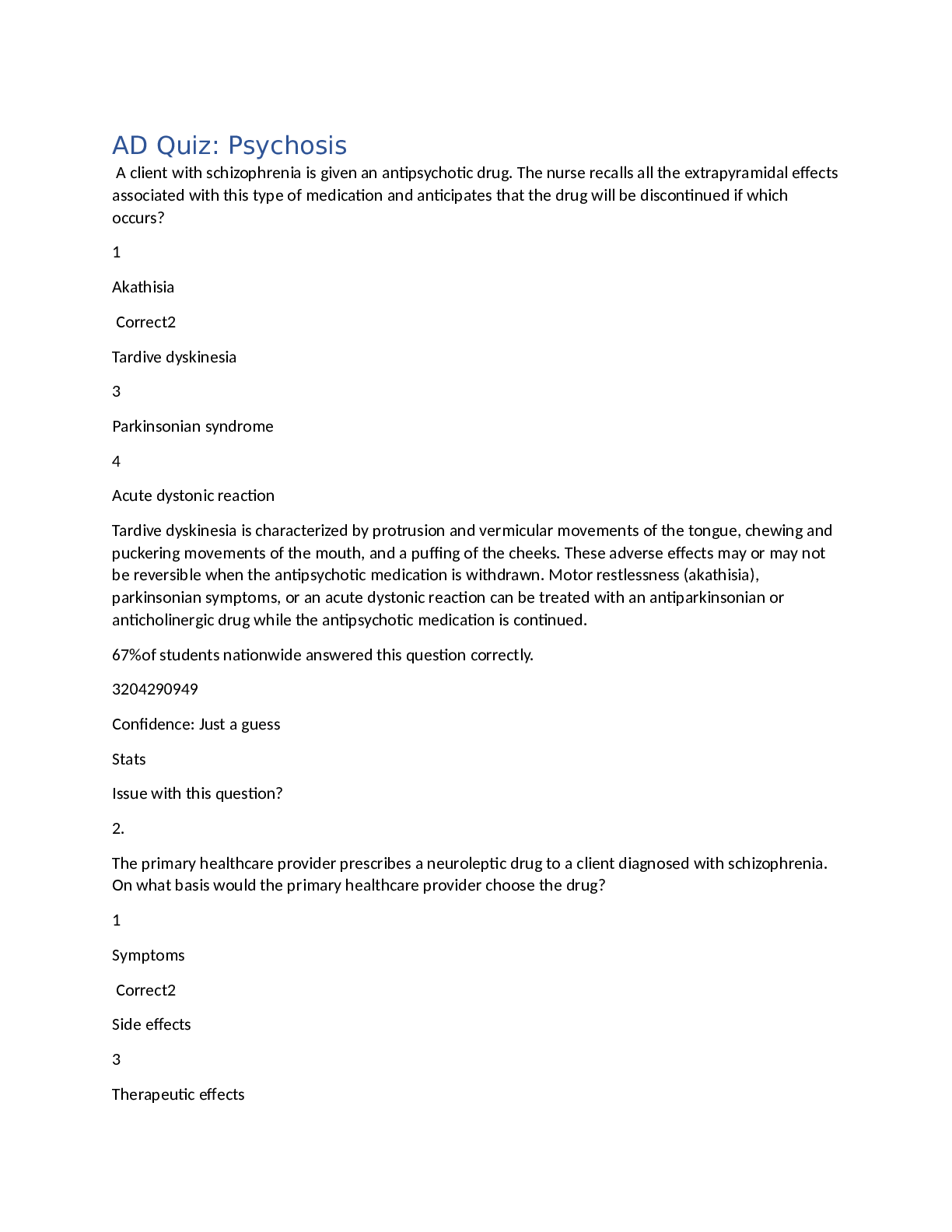

.png)
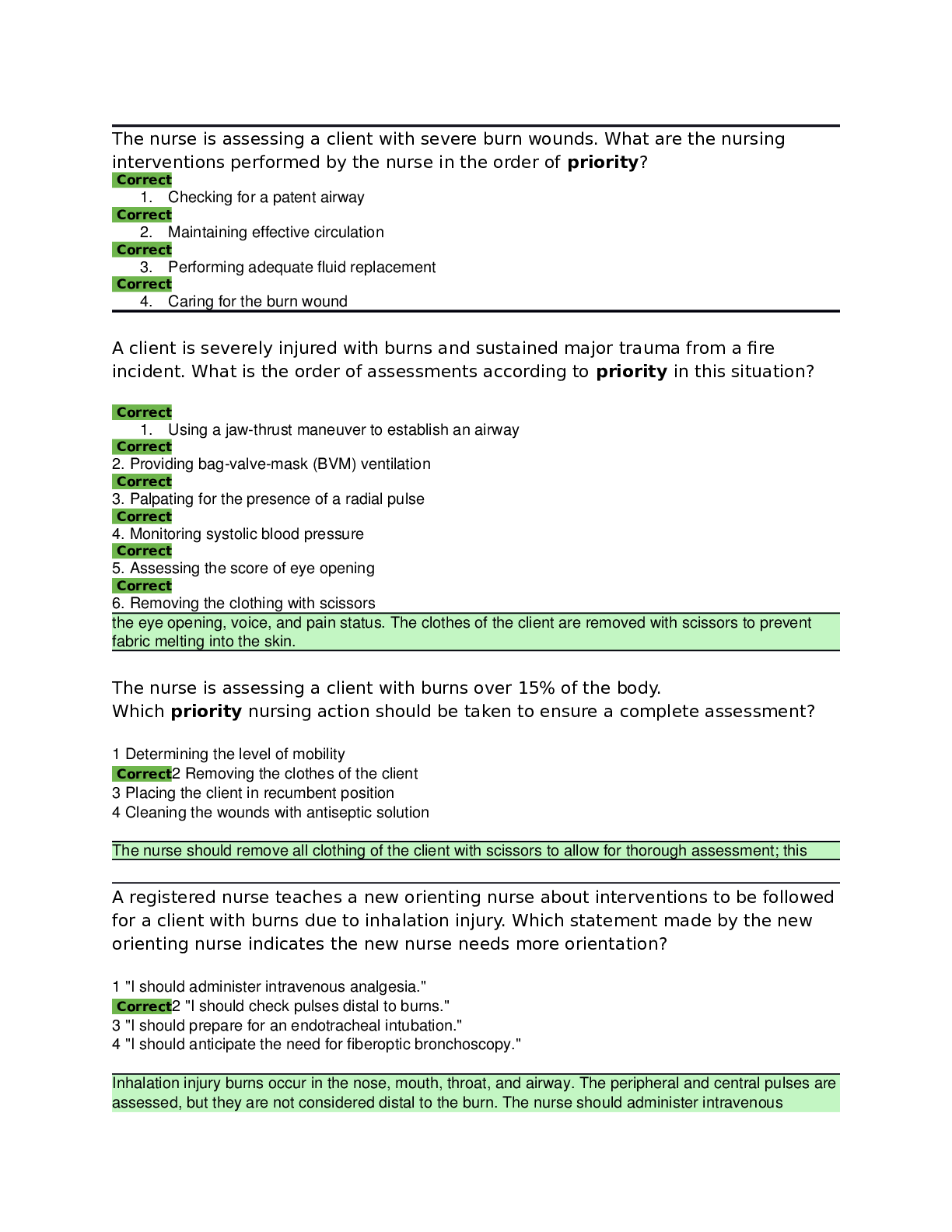
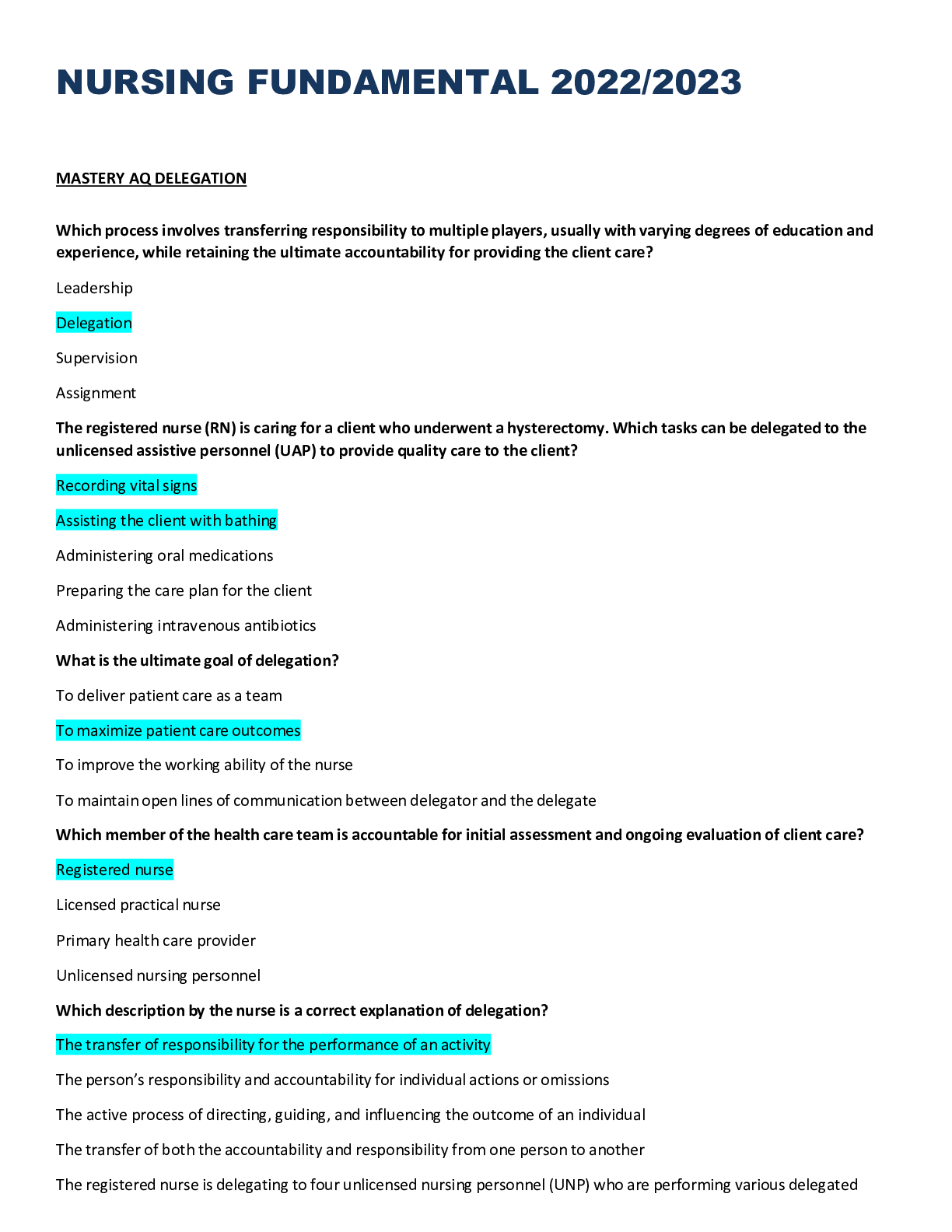

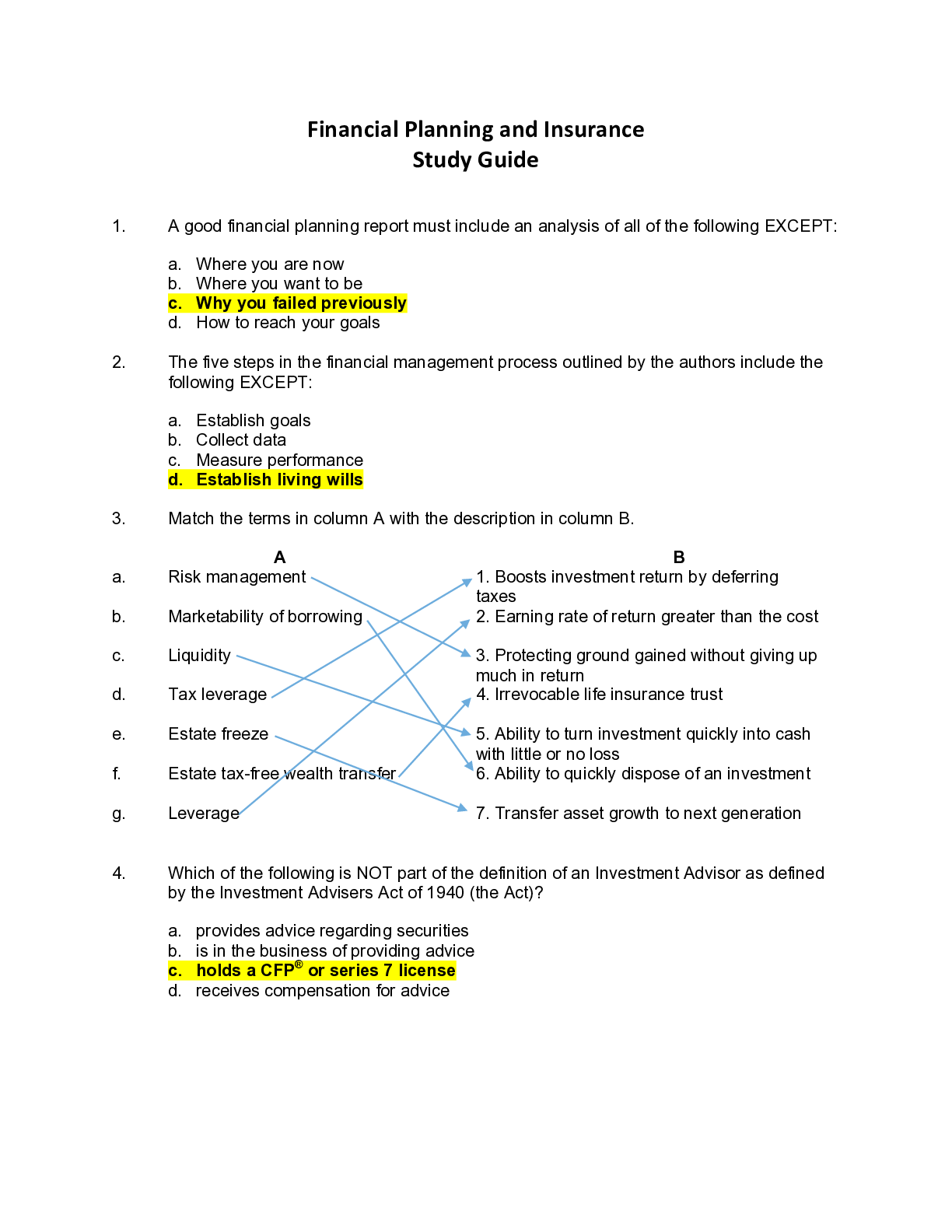



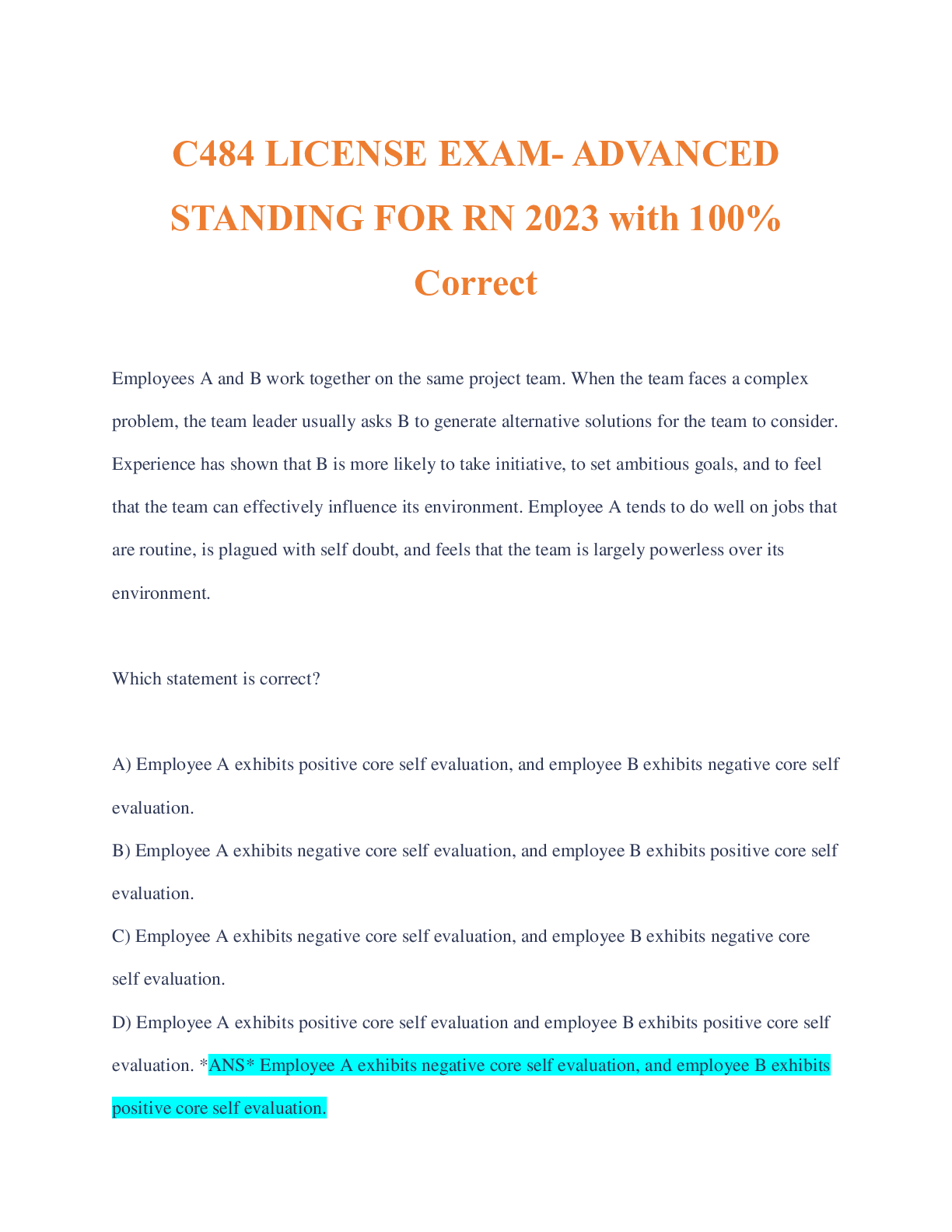
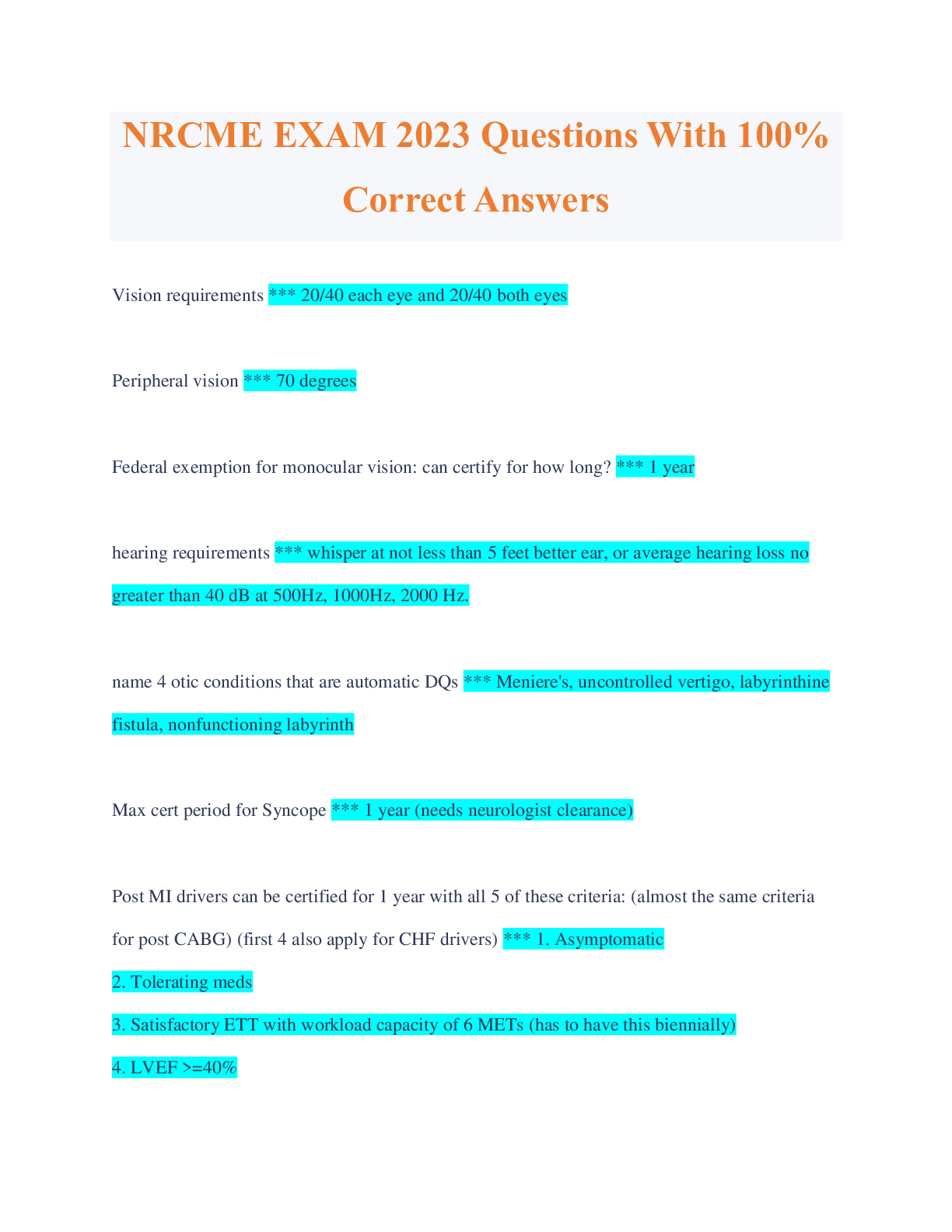

.png)
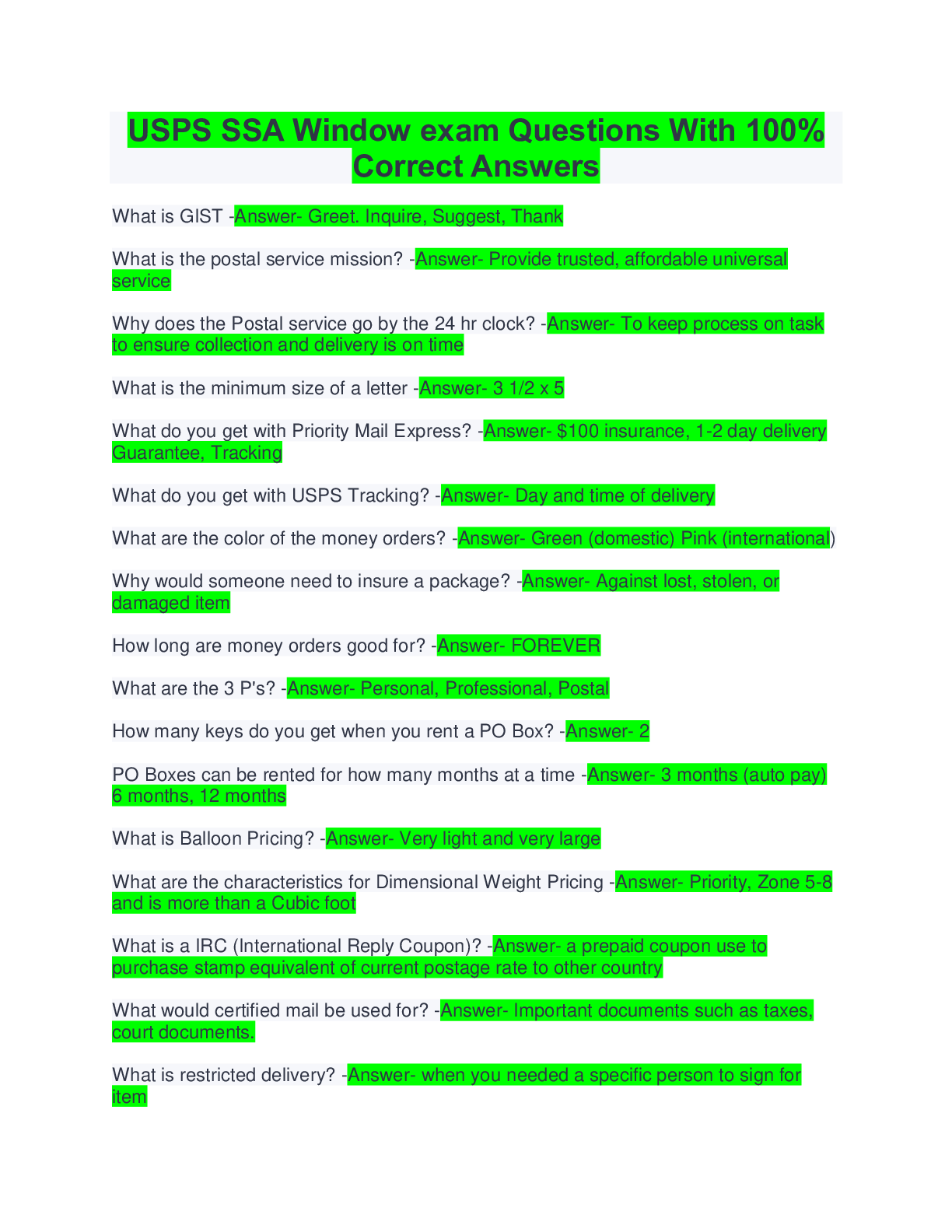
.png)

.png)
